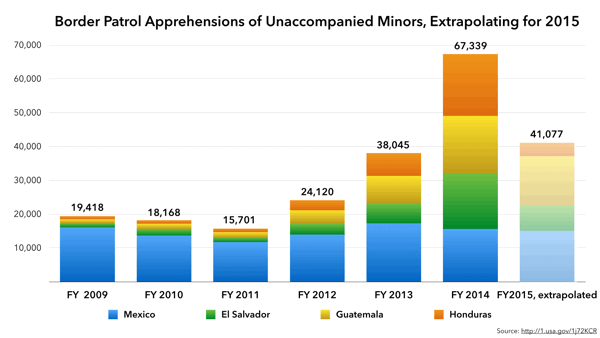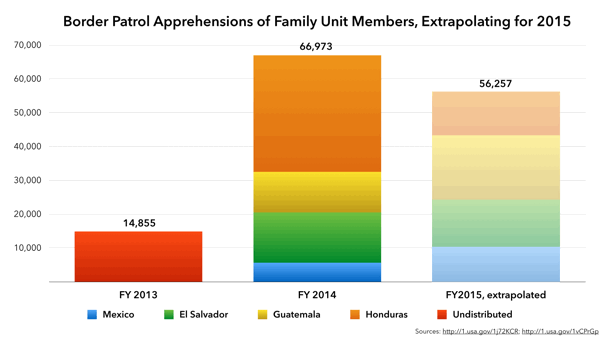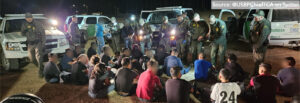For this and other balanced analysis of border security issues, see WOLA’s blog: Border Fact Check: Separating Rhetoric from Reality.
—
A wave of Central American children and families, many fleeing violence in their home countries, received heavy media attention in the summer of 2014. Then, the wave receded quickly: by August 2014, the U.S. Border Patrol was apprehending fewer unaccompanied Central American children than it was in August 2013. The humanitarian crisis disappeared from the headlines.
The Facts:
The crisis is not over. If current trends continue, child and family apprehensions in 2015 will fall behind 2014, but still exceed 2013 and every other year on record.
Border Patrol has just published its count of the number of unaccompanied children, and families with children, whom it apprehended at the U.S.-Mexico border during the first four months of Fiscal Year 2015 (since October 1). The numbers show arrivals of Central American families and children well below the record-setting pace of 2014. Compared to October 2013-January 2014, the last four months show a 39 percent reduction in apprehensions of undocumented unaccompanied children, and a 16 percent reduction in apprehensions of undocumented family unit members (parents with children).
If these rates of reduction continue through September 30, then Border Patrol will apprehend 41,077 unaccompanied children and 56,257 family unit members from Mexico, El Salvador, Guatemala, and Honduras in Fiscal 2015. Both numbers would exceed 2013—and the family-unit number would nearly quadruple that year’s total.
(Note that we do not extrapolate for the year by multiplying the last four months’ statistics by three. This would yield a misleadingly small number, as more than half of unaccompanied minors since 2009 have been apprehended between March and July.)
The data indicate a few trends:
- Unaccompanied child arrivals from Honduras are dramatically reduced. Border Patrol is on pace to apprehend 3,934 unaccompanied Honduran children in 2015, which would be a 78 percent decrease from 2014 and the lowest total since 2012. In all of 2014, Border Patrol apprehended 18,244 unaccompanied Honduran children, but in the first four months of this fiscal year has apprehended only 951.
- Unaccompanied child arrivals from El Salvador, too, are dramatically reduced. Border Patrol is on pace to apprehend 7,433 unaccompanied Salvadoran children in 2015, which would be a 55 percent decrease from 2014.
- Unaccompanied child arrivals from Guatemala are only slightly reduced. Border Patrol is on pace to apprehend 14,675 unaccompanied Guatemalan children in 2015, which would be a 14 percent decrease from 2014.
- Family unit member arrivals from Honduras are dramatically reduced. Border Patrol is on pace to apprehend 12,961 Honduran family unit members in 2015, which would be a 62 percent decrease from 2014.
- Family unit member arrivals from Guatemala and Mexico have increased, while El Salvador is little changed. Border Patrol is on pace to apprehend 18,948 Guatemalan family unit members in 2015, which would be a 58 percent increase from 2014. Border Patrol is on pace to apprehend 10,300 Mexican family unit members in 2015, which would be an 80 percent increase from 2014. Border Patrol is on pace to apprehend 14,036 Salvadoran family unit members in 2015, which would be a 5 percent decrease from 2014.
These numbers are very tentative, as sample sizes are small, October through January are months of less frequent migration, and much could change in 2015. But they appear to indicate that citizens of countries that do not border Mexico are migrating in smaller numbers this year, while Guatemalan citizens continue to arrive at or near 2014 levels.
We do not yet know what might be dissuading Salvadoran and Honduran families and children—but not Guatemalan ones—from attempting the journey to the United States. Violence and poverty conditions are either not improving or not improved enough to make a difference. Central American security forces’ stepped-up migration enforcement—some of it with U.S. support—may be a cause. So might Mexico’s crackdown on migrants in its territory, especially its southern border zone: last year, Mexico captured and deported 104,269 citizens of El Salvador, Guatemala, and Honduras in 2014, a 34 percent increase over 2013.
Stepped-up enforcement raises concerns about the safety of migrants who fail to flee threats and violence. But is a likely cause for the recent reduction in the number of migrants who make it to the United States. This reduction, though, is easy to overstate: the numbers show that 2015 is on track to be a very heavy year for child and family migration.




